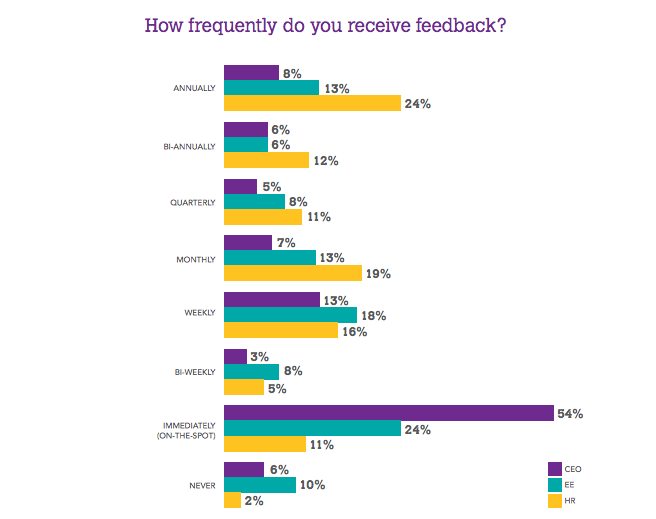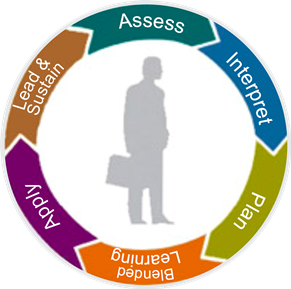
As we charge through the age of analytics and instant feedback, many old systems, tools and processes are falling by the wayside.
The standard annual performance review is one of the victims being claimed and, for many organizations, it’s being replaced by a solution called the 360 degree performance appraisal – also known as a performance review.
The reason for this shift is that companies are seeking more productivity, efficiency and workplace contentment from their leaders and employees.
Arguments For Using 360 Degree Performance Appraisals
To understand why 360 degree performance reviews are gaining popularity, it’s important to review the standard annual performance review.
Standard annual performance reviews have long been a dreaded exercise in companies of all sizes. For employees, they create added anxiety and extra work. For executives and leaders, they result in higher costs and slowed productivity.
And, despite the best intentions of leaders implementing these performance reviews, there are often no real results to speak of once the reviews are completed.
But this is far from breaking news. Fortune shined a light on the ineffectiveness of annual performance reviews back in 2012, sharing a survey that revealed that despite “virtually all the companies surveyed use[d] some form of annual evaluation as their chief means of giving performance feedback to employees, only 2% of HR people think these reviews accomplish anything useful.”
Annual Reviews Build Disconnects Between Leadership And Employees
Even worse than using employee performance tools that don’t work, annual reviews create a larger disconnect between executives and their managers and employees. According to Fortune, there’s a major “disconnect between what CEOs think is going on below them and what employees say actually happens.”

The study goes on to cite that, “57% of CEOs believe their people are ‘regularly recognized’ for their hard work and contributions,” while only 9% of employees agree. Additionally, “61% of employees say they would welcome immediate, on-the-spot feedback from bosses and peers about how they’re doing, [but] only 24% say they get it. Meanwhile, 54% of CEOs believed they already provided immediate feedback.
This is what makes 360 degree performance appraisals so attractive. The 360 degree appraisal offers managers the ability to more quickly gather data that is easy to interpret.
So, what’s the problem?
How 360 Degree Performance Appraisals Are Failing Leaders, Managers and Their Employees
We can all agree that the old way of conducting employee performance reviews falls short due to its one-dimensionality. There is typically very little two-way conversation involved and the actions that are taken afterward are oftentimes siloed, leading to disconnects between employees, managers and executives.
The 360 degree performance appraisal, which leverages feedback from multiple parties, seems like a great alternative for a more holistic picture of the status and future of leaders and employees.
However, there is a “fatal flaw” when using 360 degree surveys for appraisals. According to Harvard Business Review (HBR), that flaw is subjectivity.
Instead of acquiring objective results, 360 appraisals count on managers to rate their leaders and employees based on different competencies. This means the ratings are based on the rater’s opinion and makes it very likely to be biased, no matter how objective the person may claim to be.
Some organizations attempt to remedy this by having multiple people provide ratings for employees. The issue with that, according to HBR, is that although it seems like adding more opinions would help provide a more rounded picture, all it really does it provide more “bad data.”
In short, 360 degree performance feedback results in data that is biased and should be avoided, right?
Not necessarily…
How 360 Degree Feedback Can Be Beneficial
While 360 feedback may be based on individual opinions, it’s still true that it uses a holistic approach that includes two-way feedback instead of just one-way communication. The real problem exists in the application of the feedback.
In order to be most effective, it’s best to use 360 degree feedback as a tool to support developmental plans, which can be tied to appraisals but not used solely to make decisions. When used this way, 360 degree feedback can be very helpful for individual development, improving accountability, aligning performance goals and values and more.
Now that you understand the right and wrong ways to implement 360 degree feedback assessments, it will help to understand how they actually work.
Click here to view a sample 360 assessment
How Effective 360 Degree Performance Feedback Works

While 360 evaluations from different vendors may vary a bit, most share a common approach for implementation. For the most part, 360 evaluations can be broken down into six steps that come together to form the comprehensive, 360-degree approach that make them so effective.
Assess Skills, Behaviors And Competencies
The first step is assessment of the organization’s leaders or employees. During the assessment step, individual and group skills, behaviors and core competencies are measured. The core competencies can be customized depending on the specific organization and industry in order to get highly relevant results.
Interpret & Report The Results
The next step is to analyze the assessment results and identify individual and group strengths as well as the employee’s developmental needs. This analysis will act as the foundation for action that is taken going forward.
The assessment stage and the interpretation stages are also great opportunities for leadership to gain insights from the employees and leaders that they’re managing. This type of two-way engagement really sets the 360 degree appraisal process apart from other forms of performance review.
Create An Action Plan
Once the results are interpreted and presented, it’s time to create a performance action plan and identify learning opportunities. This is an opportunity for collaboration, as the employee and manager can clearly identify and document the employee’s current standing and highlight the best ways to move forward with development.
Take Advantage Of Development Tools & Resources
With an action plan in place, supervisors can guide employees through the development and improvement process by leveraging a combination of internal resources and action tools, such as e-Learning courseware and counseling or coaching services.
Apply The Training To Meet Business Objectives
With the help of developmental tools and resources, employees will begin to erase the knowledge gaps and align their knowledge and skills with the organization’s business objectives and strategies.
Maintaining A Proactive Developmental Approach
With action plans in place and learning resources being utilized to improve strengths and develop need areas, employees and leaders should be proactive in maintaining the direction of their development. In this stage, progress should be measured using post-assessment monitoring and collaborating.
Why You Actually Should Use 360 Degree Performance Assessments
To get the most out of your company, it’s critical that you are leveraging your leaders and employees as much as possible. Traditional performance reviews simply fall short when it comes to comprehensive assessment and development.
Using 360 degree performance assessments can be useful to empower your employees and leaders when they are used the right way. The wrong way is to count on them solely to make appraisal and compensation decisions. However, when used in combination with other assessment tools, they can offer great resources for continued development over time, which in-turn leads to growth for your company.
So leave the annual performance reviews for those organizational leaders who are comfortable staying the same and start growing your business to its full potential with 360 degree performance assessments. Just be sure to implement them the right way.

